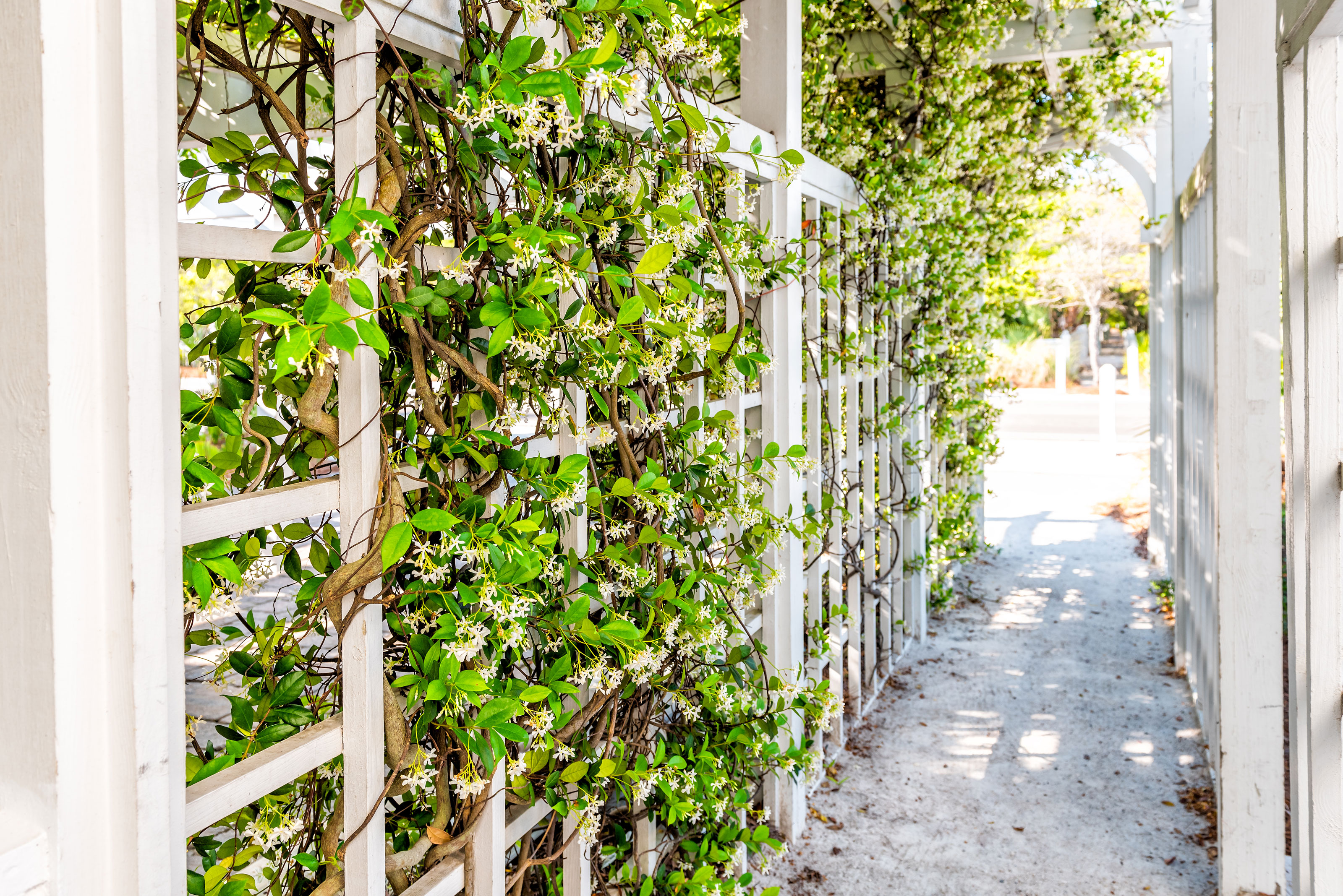
If you're looking for some extra privacy, or you're dealing with a rather dull and boring fence, you don't have to worry — we're here with a solution. It's time to find the best plants to cover a fence that will add a touch of color, character and allure to your backyard.
Nature in all its glory, is a fine way to design and style a plain fence. Whether you're looking to plant privacy trees or you're trying to find the right blooms, garden fencing ideas are always a fun way to decorate and elevate a space.
From fast-growing climbing plants that add privacy to flowers with bright foliage that just make a statement, however you choose to style your privacy fence, we're here to make the journey a little easier. Here are 10 beautiful plants to cover a fence — that will no doubt elevate your backyard.
1. Jasmine

When small backyards are overlooked or shady — this is where jasmine can step in to transform a problem fence into something special.
Masses of small yellow flowers and green stems throughout winter make winter jasmine (Jasminum nudiflorum) a popular choice for covering a shady or north-facing fence year-round. It responds well to be trained against a vertical surface as its natural inclination is to flop.
As for the ever so enticing star jasmine (Trachelospermum jasminoides), this bloom has highly scented white flowers and its vigorous growth makes one of the best plants to cover a fence. Although it likes full sun it works in shady spots too. Another plus, is that it's heavenly scented.
Hardiness zone: 7-10
Soil type: Moist, Well-drained
Sunlight: At least 6 hours of full sun
2. Clematis
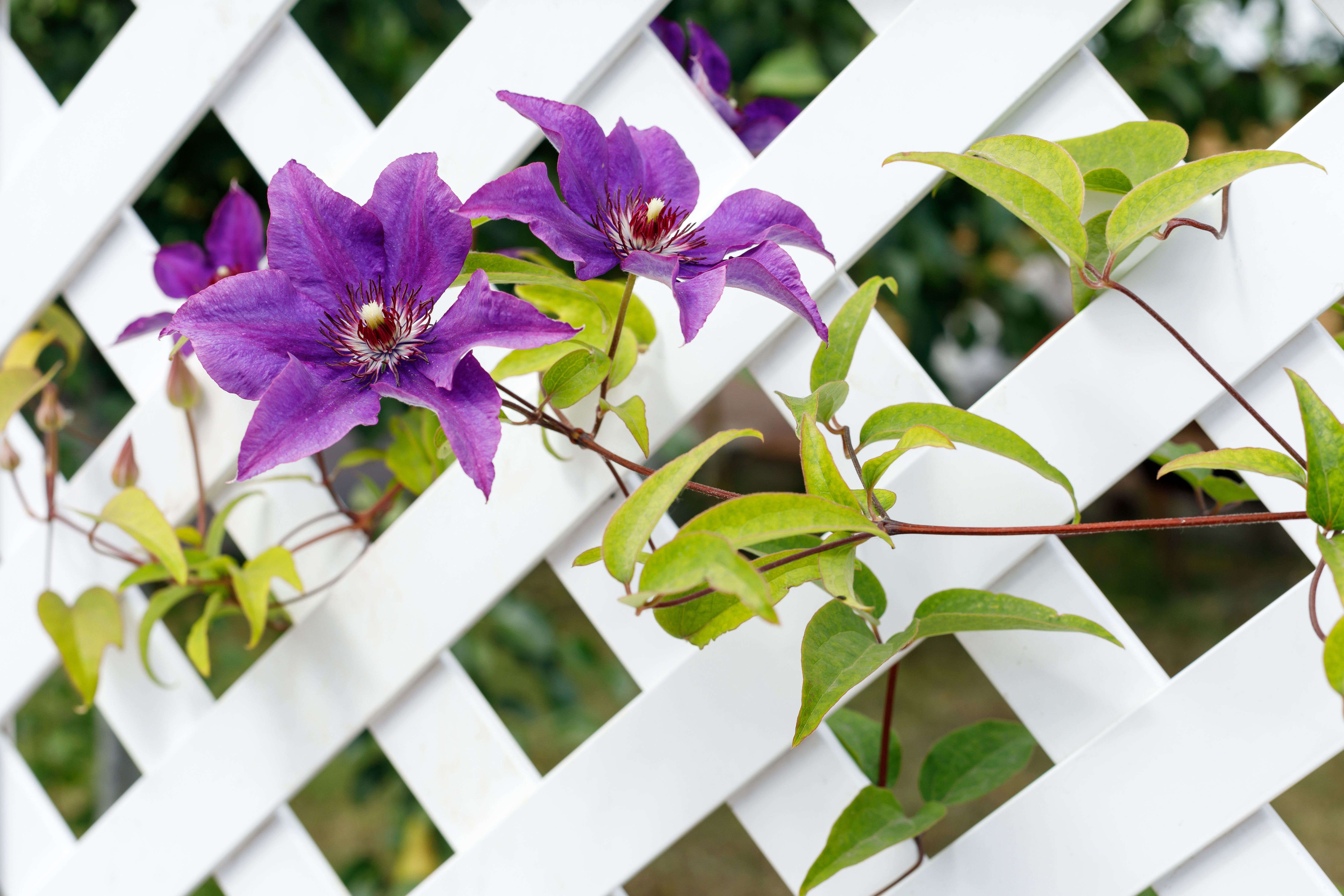
Clematis is one of the most popular climbing plants, and deservedly so. Not only do they offer excellent cover for unsightly garden fences, they also grow fast, which makes them a grat plant for privacy when speed is your aim. There are many clematis varieties that flower in all the different seasons of the year and, best of all, they come in a range of different colors and shapes.
One of the best twining climbers you can choose, they still need a good framework to grow up. It's also important to remember they prefer their flowers and foliage in the sun and their roots in the shade. 'With over 300 varieties, clematis is an outstanding climbing plant for covering fences,' says plant expert Ben Hilton from The Gardening Fix. 'It's one of the few fast-growing flowering plants that bloom against a north-facing wall, if you choose varieties such as clematis armandii or Montana.'
Armandii is an early spring flowering, vigorous, evergreen variety, with saucer-shaped, scented white single flowers. Montana 'Elizabeth' is another popular choice as it's such a vigorous grower (often described as rampant!) and has a lovely fragrance too.
Hardiness zone: 4-9
Soil type: Moist, Well-drained
Sunlight: At least 4 hours of full sun
3. Climbing hydrangea
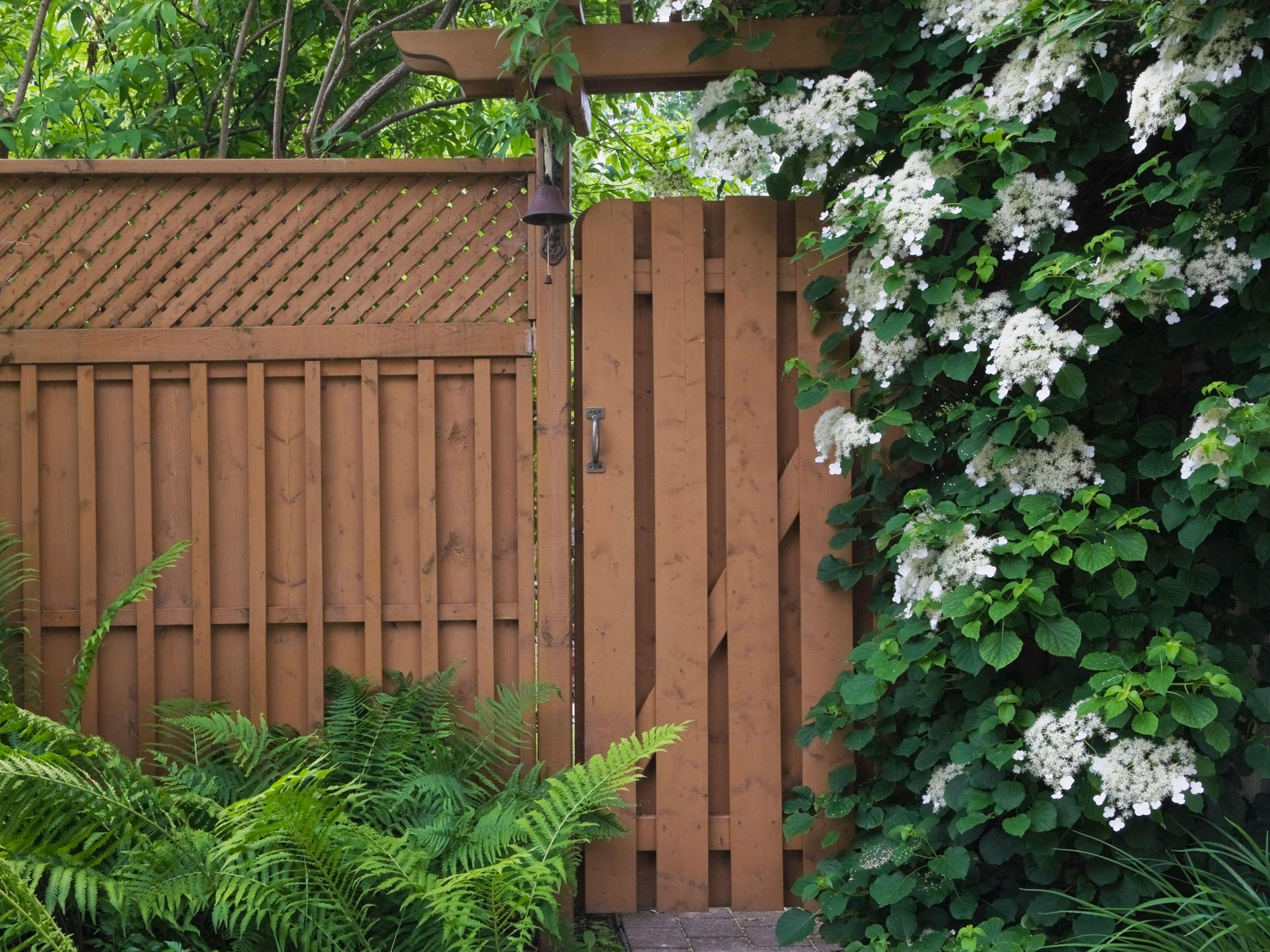
When choosing plants to cover privacy fences, a climbing hydrangea is one of the easiest options. It requires no maintenance, is easily trained and looks attractive year round.
Climbing hydrangeas add texture and interest to transform an ugly fence into something beautiful, and can also attract beneficial garden insects to your yard. They are vigorous growers but it can take several years before they flower. The best-known climbing hydrangea is Hydrangea petiolaris, which grows to around 20 feet and will creep along the fence sideways, and also look great as climbing plants for the front of your house.
'Climbing hydrangea is a great option for covering a fence,' says David Angelov, founder of PlantParenthood. 'It's a woody vine and some varieties can grow up to 50 feet long. It produces large clusters of white, fragrant flowers in the summer. It's also easy to grow and can tolerate a variety of growing conditions, including shade and partial sun.'
Hardiness zone: 4-9
Soil type: Moist, Well-drained
Sunlight: Full sun to part shade
4. Ivy
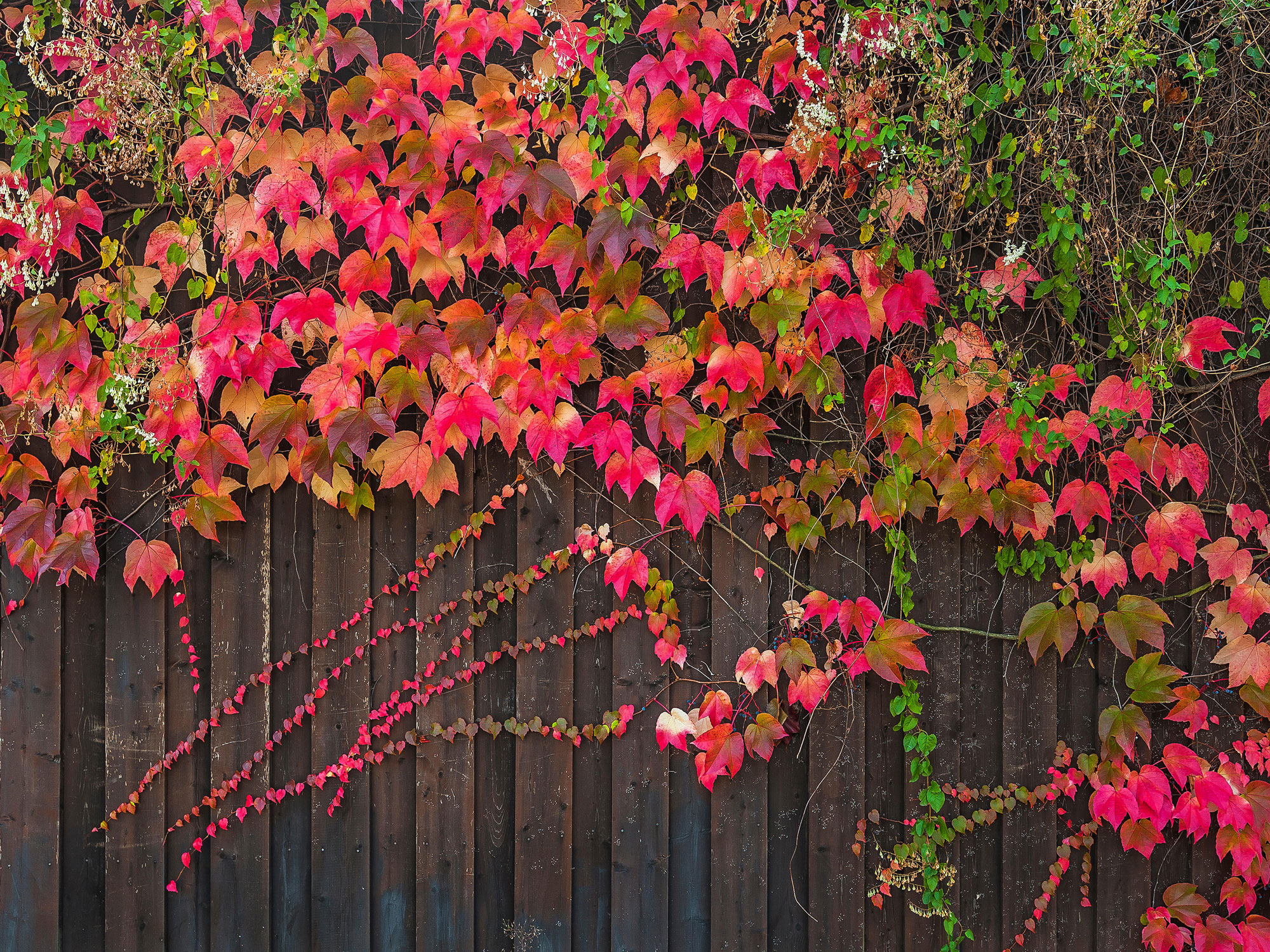
If you want to green up a dull fence with foliage fast, choose ivy. 'It's an attractive, evergreen, easy-to-grow, shade-loving vine that clings neatly to fences, walls and tree trunks and often features prettily patterned foliage,' says gardening expert Graham Rice. 'It's an indispensable plant, tolerating deeper shade than any other vine, but it can be invasive, especially in the West and Midwest.'
Boston ivy (Parthenocissus tricuspidata) grows quickly and will cover a large or small garden fence well. The leaves change colors through the seasons, going from deep green in summer to orange or purple in the fall, and bronze in the spring. If you have a chainlink fence try Persian ivy (Hedera colchica). It takes about five years to grow 10 to 15 feet, is self-clinging and evergreen, with large attractive leaves.
'Ivy shoots may need guiding in the right direction before they take a grip,' says Graham. 'The simplest approach is to use a small piece of duct tape to fix the stems to the climbing surface.'
Hardiness zone: 4-13
Soil type: Well-drained, loamy
Sunlight: Bright, indirect sun
5. Honeysuckle

A privacy fence covered with beautiful honeysuckle vines is an attractive planting option, as you can enjoy the sweet scent all summer long. It's easily achievable in your own yard too. Honeysuckle plants have strong tendrils that attach to fences, but they can crowd other plants, so make sure you give them their own exclusive space.
When it comes to choosing a variety there are many that are native to North America so there's sure to be one that's at home in your area. If there isn’t, then choose one that will survive your local climate. You can't go wrong with Lonicera sempervirens (trumpet honeysuckle) or Lonicera periclymenum (common honeysuckle) as fence-covering options.
Most honeysuckles need at least six hours of direct sunlight each day to thrive so be sure your fence is the right spot. Given the right conditions, honeysuckle will grow vigorously, making it one of the best flowers for beginner gardeners. Pruning in winter, when the plant is dormant, is essential to keep your honeysuckle plant contained to the fence.
'I've got some honeysuckle on my fence, and I love it,' says Livingetc's executive editor, Pip Rich. 'It has been super easy to grow from a young plant, and it smells so fragrant and looks so delicate. Would highly recommend.'
Hardiness zone: 5-9
Soil type: Rich, well-drained
Sunlight: Full sun and light shade
Priced from: $36.64
Size: 1 Gallon
Mature height: 8-10 feet tall
6. Climbing rose 'Iceberg'
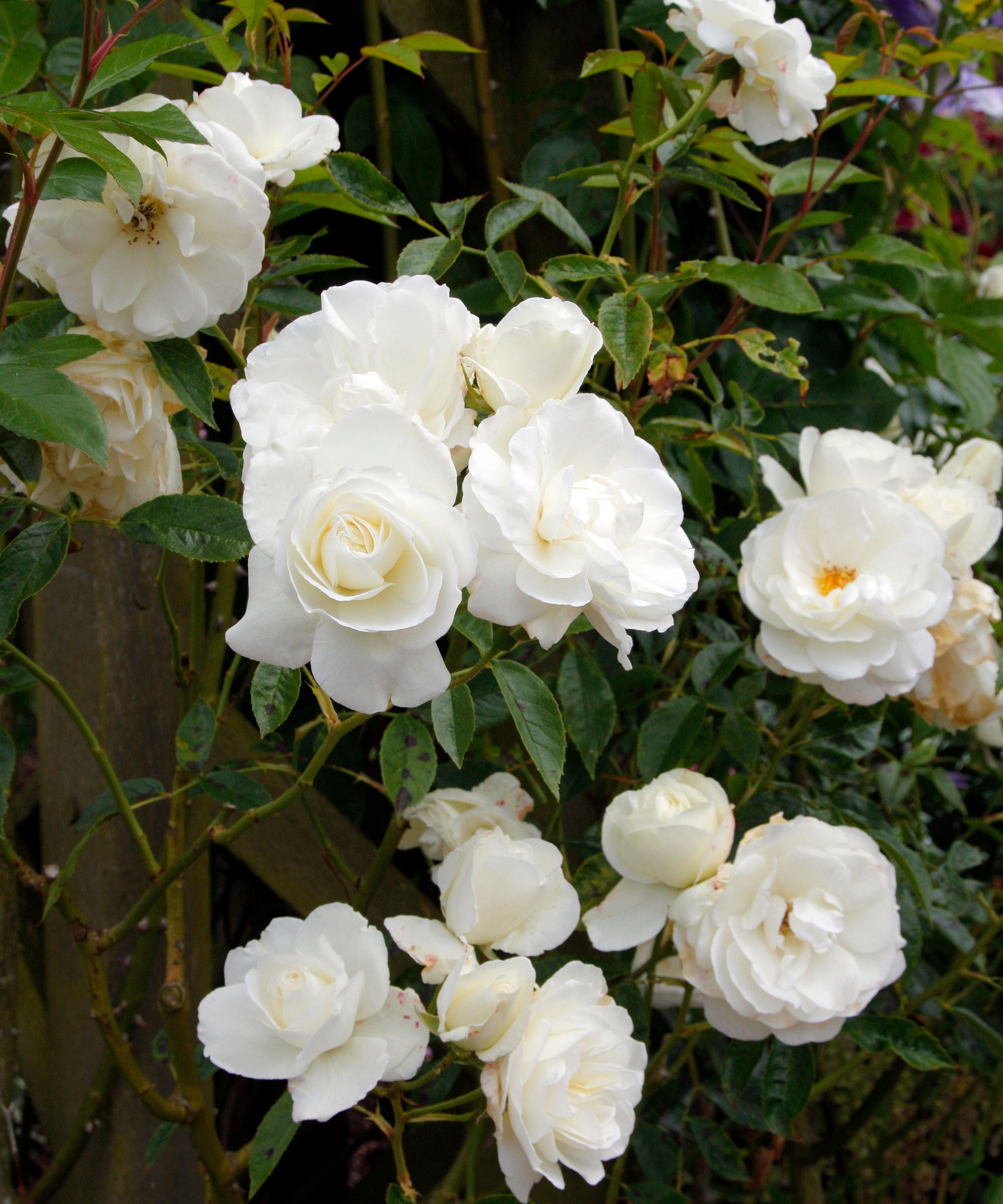
Training climbing roses on a fence is easy and the result is always beautiful. Roses are a good choice for every kind of fence from chain link to wooden picket, and work whatever the style of your backyard. There are so many varieties to choose from, too, so you can even find a climbing plant that likes shade among them.
My favorite climbing rose for fences is 'Iceberg'. I have one rambling all over a fence in my backyard, and it has two flushes of beautiful soft-white blooms with the faintest pink tinge, one in late spring and another towards the end of summer.
It's easy to train too and the stems will go where you want them to. I rarely remember to prune it but this doesn't hold it back and it keeps on giving, covering the fence with masses of flowers year after year. Another plus, is that the foliage doesn't die back in winter either, so the fence stays looking 'green'.
Hardiness zone: 5-9
Soil type: Well-drained
Sunlight: 6 hours of direct sun
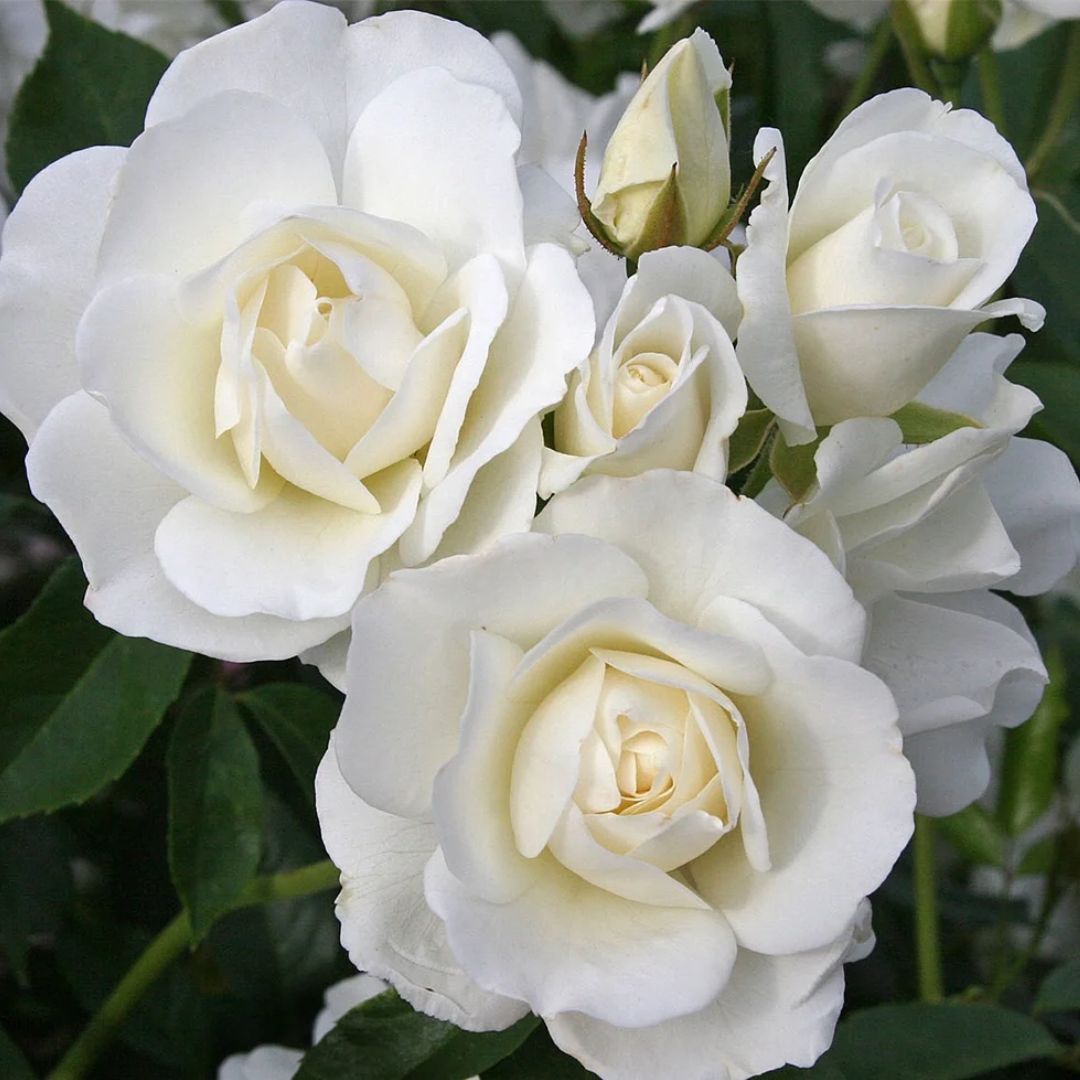
Priced from: $67
Height: 12-15 inches tall
7. Wisteria
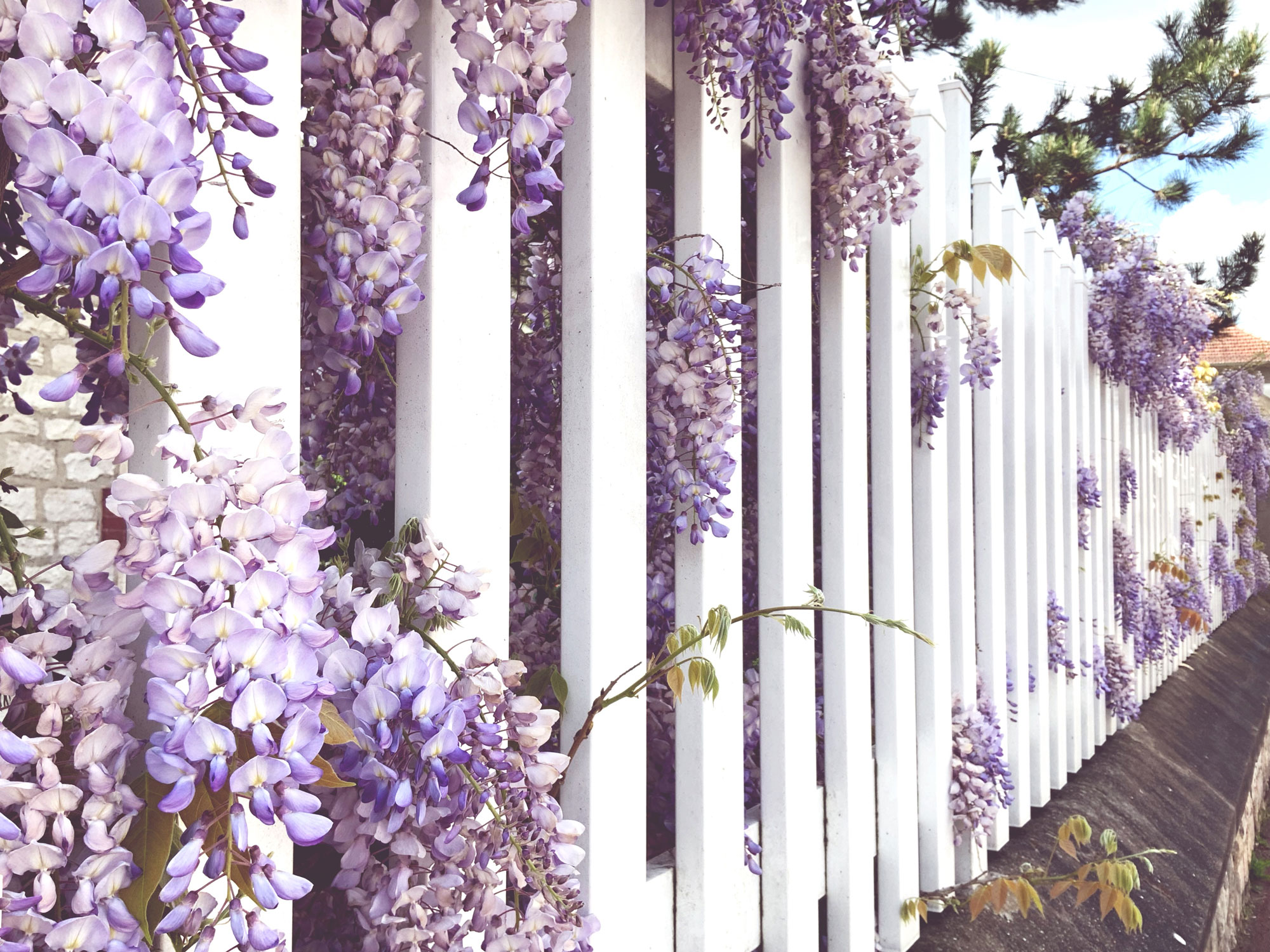
One of the most beautiful plants you can choose to cover a fence (especially a white picket fence), the pendulous blooms of wisteria are always a big hit. But as fashionable and evocative of Hamptons-style decor as it is, this is one climbing plant that can cause consternation, as it has a tendency to dwarf its designated space. While some climbers need very little pruning, wisteria definitely needs to be reigned in.
The best variety for fences is Wisteria sinensis (Chinese wisteria), as it performs well on vertical surfaces. Train shoots along strong, taut wires fixed horizontally along the fence. Use soft twine to tie shoots onto these wires.
When it comes to keeping your wisteria under control, there are a few simple points to remember. Cut back the current year’s whippy shoots to just five or six leaves in summer, then give it a second cut in late winter, pruning back to two or three buds. You can also hard prune them to get rid of old wood. That's it — easy.
Hardiness zone: 5-9
Soil type: Moist, well-drained
Sunlight: 6 hours of full sun
8. Bamboo
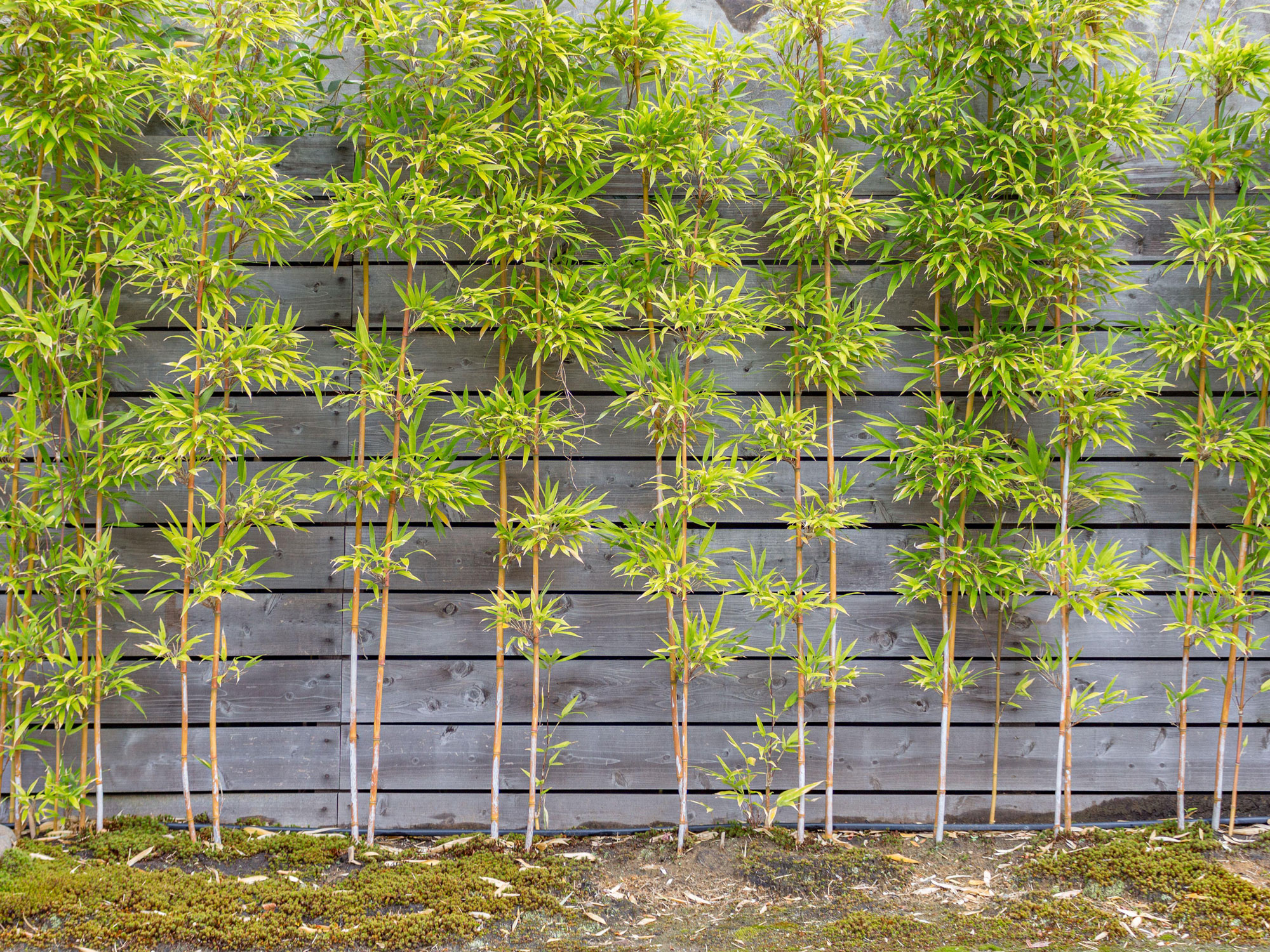
As well as climbing plants, shrubs and trees can some of the best plants to cover a fence. For attractive screening that grows tall and offers a green wall you can't beat bamboo, especially for overlooked urban gardens, as it's one of the best plants for privacy. The canes form an airy green screen that shifts and ripples in the breeze to add movement to your planting. The rustle of foliage can also help to screen city noises to enhance the tranquillity in your yard.
'Bamboo is a fast-growing, evergreen plant that can provide excellent screening,' says Amy Hovis, co-owner of Barton Springs Nursery. 'Some of the best bamboo varieties for screening are clumping bamboo species like Bambusa multiplex, Bambusa textilis, and Bambusa oldhamii.' Amy's top tip is to make sure to choose clumping bamboo as opposed to running bamboo so that it doesn’t spread into your yard or those of your neighbors, as it can be highly invasive.
As always, remember to consider factors such as soil type, sun exposure, and water availability when selecting plants for screening. 'Also, it's always best to choose native plants when possible, as they are better adapted to the local climate and can be more resilient,' adds Amy. 'It's even more important to choose plants that will succeed in our changing climate.'
Hardiness zone: 4-10
Soil type: Well-drained, loamy
Sunlight: 5+ hours of direct sunlight
Priced from: $104.95
Quantity: 1
Mature height: 30 ft
9. Burkwood Viburnum
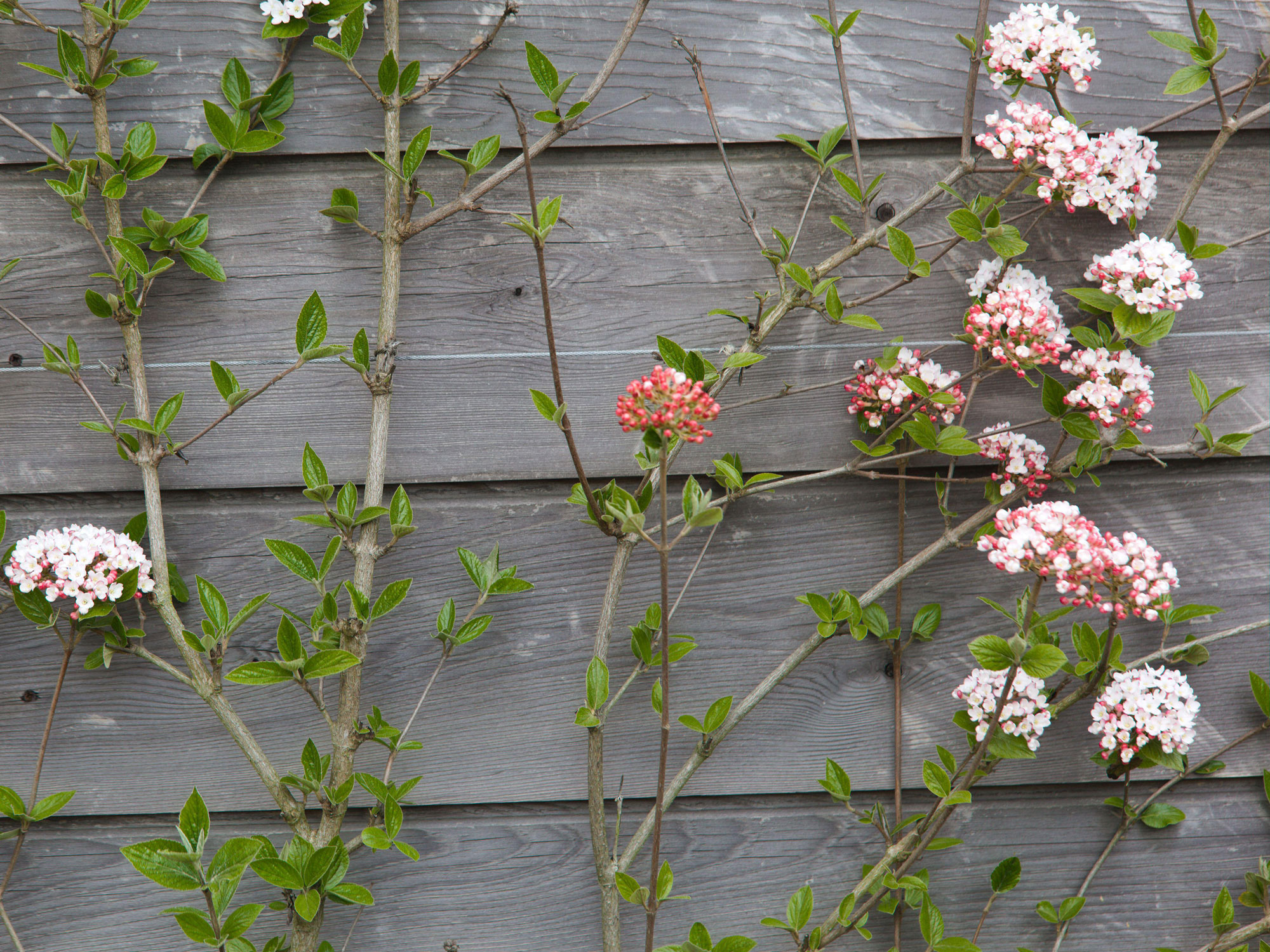
With light pink buds that open to white flower clusters, several Burkwood Viburnum (Viburnum x burkwoodii) plants like these ones from Nature Hills can be planted in a line in front of a fence to create an attractive screening hedge that will rarely need trimming.
Space them three and a half feet apart, measuring from the center of one to the center of the next. Add additional rows in a staggered, zigzagging planting pattern, and once established, your fence will be fully disguised. They're ideal flowers for hummingbirds and butterflies flock to the nectar-packed clusters of blooms, so they are one of the best plants to cover a fence if you want to attract wildlife to your yard. Landscape designers often rely on these gorgeous shrubs to deliver year-round beautiful results as the leaves remain evergreen in warmer climates.
'There are many cultivars of viburnum, but all are known for their dense foliage and showy flowers, which makes them ideal for screening a fence, especially as they're very fast-growing,' says Amy Hovis. 'They do best in full sun but do well in part shade as well, and make a great screening hedge.'
Hardiness zone: 4-8
Soil type: Well-drained, moist, loamy
Sunlight: Full sun to part shade
10. Trumpet vine
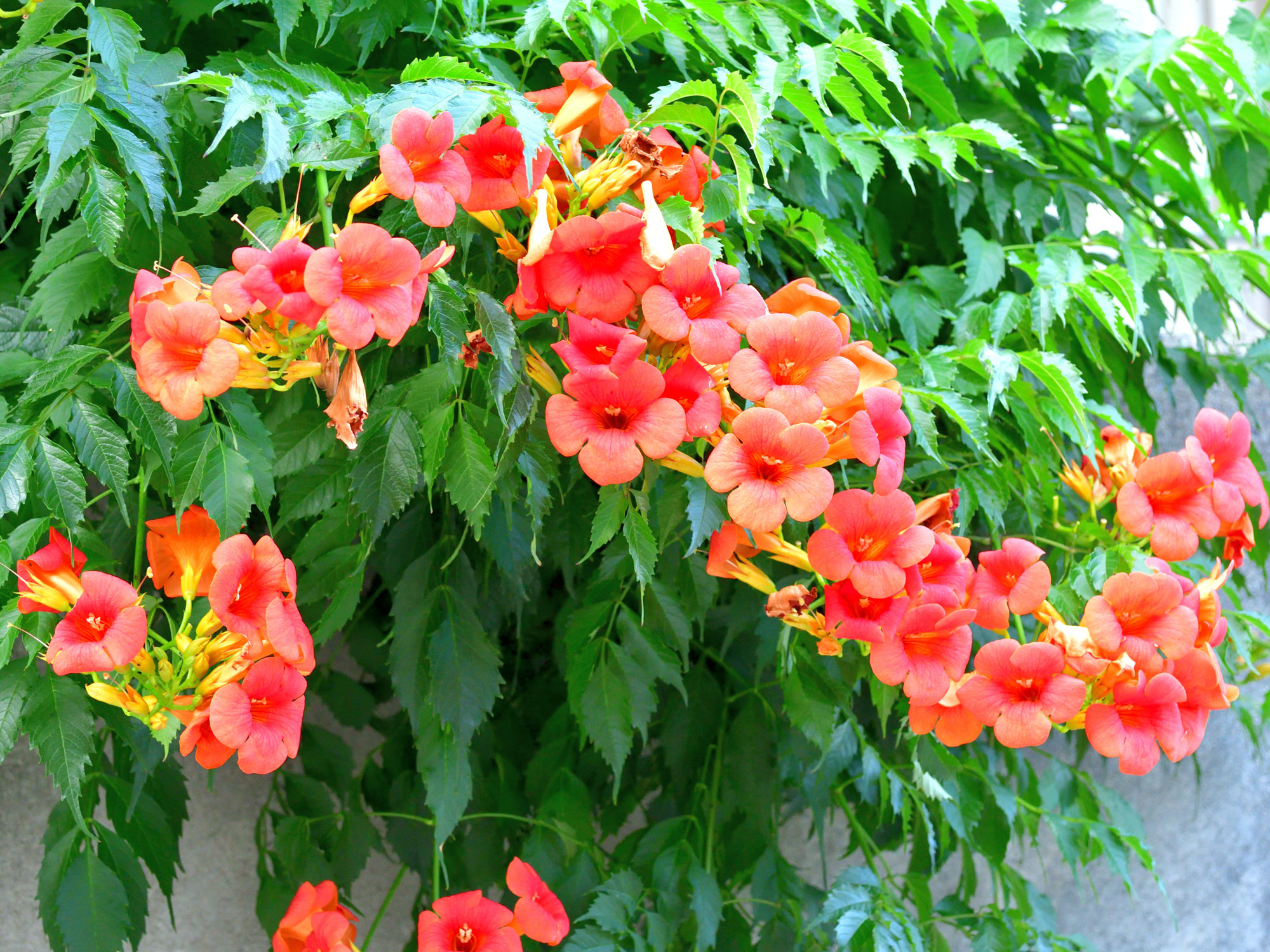
The vivid coral-color blooms of trumpet vine (Campsis radicans) will mask and soften an unsightly fence while acting as a beacon for hummingbirds who cannot resist them. This vigorous vine, a US native, will cling to a fence and spread along it rapidly while being a low-maintenance option too.
Keep trumpet vine contained by trimming it regularly. 'It can be cut back hard in winter and will grow back in the blink of an eye, so be as aggressive as you want with it,' say the team at Omaha-based plant nursery Nature Hills. 'Be on the lookout for runners and be ready to pull them out. This prolific grower also seeds easily and spreads rapidly.'
If you're in need of a vivid, vibrant, and hummingbird-friendly creeper to beautify a boundary, trumpet vine is one of the best plants to cover a fence.
Hardiness zone: 4-9
Soil type: Moist, well-drained
Sunlight: At least 6 hours of direct sun
Priced from: $31.01
Mature height: 20-30ft
FAQS
What is the fastest growing climbing plant for a fence cover?
If you're looking to add extra screening onto your fence, then fast-growing plants are sure to be on your radar.
So, which beautiful blossom tops the chart for the fastest-growing bloom? Well, there are a few, but if I had to pick one, it would be the ever so abundant and colorful clematis — also known as 'The Queen Of Climbers'.
Clematis comes in a variety of different colors, as well as vine types that adapt well to sunny and or shady spots in the backyard. Remember, different varieties grow at different speeds, but some can grow over 20 feet within just one year.







